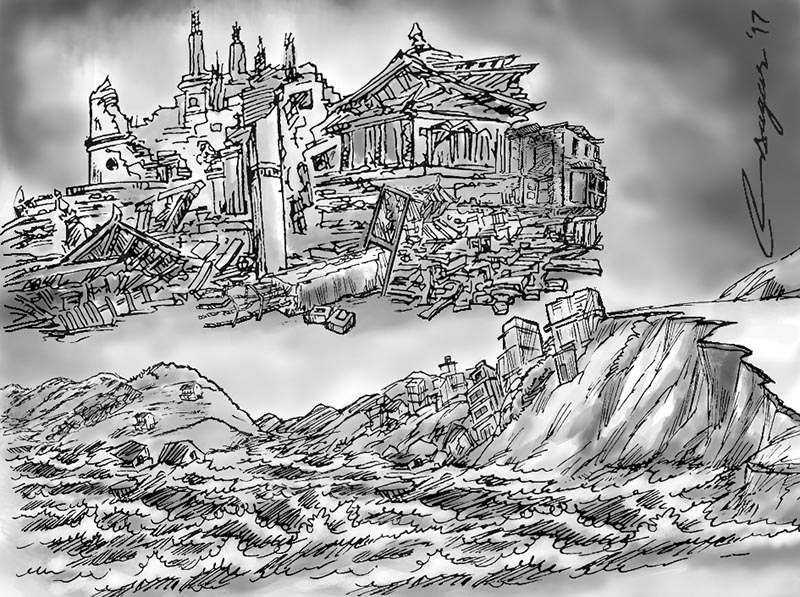Disaster risk reduction: Critical for Nepal
It is projected that the world will have to address even harsher effects of greenhouse gas emissions in the coming years. Poverty, rapid urbanization, poor land use, ecosystems decline and other risk factors will amplify the impacts of climate change
Natural disasters such as floods and landslides have long been a routine phenomenon in Nepal. Records for the past 46 years show that natural disasters have claimed on average nearly 900 lives every year, have rendered hundreds of thousands of families homeless and caused extensive damage to property.
While there is no denying the fact that Nepal’s topography increases the propensity for hazards like earthquakes, riverine floods, flash floods and landslides, the reasons these hazards turn into disasters are all man-made.
In the April 2015 earthquakes, Nepal witnessed one of the biggest tragedies in its history with the loss of nearly 9,000 people. They were killed as a result of weak infrastructure that collapsed during the earthquake. In comparison, the 2016 earthquake in Chile, which was stronger, did not lead to human casualties mainly because of strict enforcement of building codes. Indeed, earthquakes do not kill, weak buildings do. This year witnessed one of the worst floods in recent times in South Asia that affected 29 districts in Nepal, killing 160 people. It also destroyed 43,000 houses, affecting another 191,000, damaged public infrastructure like roads, bridges, embankments, canals, and washed away standing crops and other livelihoods worth over NPR 8 billion.
The government recognises these risks and has accorded high priority to disaster risk reduction. As a significant step in that direction, the Parliament passed the Disaster Risk Reduction and Management Act, 2074 which will result in setting up a high-level Disaster Risk Reduction Authority in government.
This new Act has provisioned roles and responsibilities for the Federal, Provincial and Local level governments as per the new Constitution. It also provides for a National Disaster Risk Reduction and Management Council headed by the Prime Minister as the highest policy making and coordinating body for disaster risk management.
The Ministry of Home Affairs, which is the nodal ministry for disaster risk reduction in Nepal, is now leading an initiative that engages a range of stakeholders, from ministries and departments of government, to non-government organisations, UN and international agencies, development partners and private sector with support from the United Nations Development Programme and the DP-Net to prepare a National Policy and Strategic Action Plan For disaster risk reduction. This National Strategic Action Plan will set targets and identify actions to reduce mortality, with a corresponding decrease in the number of affected people.
This is nearing completion and Nepal will become the second country in the region after India to develop a national plan in line with the Sendai Framework for Disaster Risk Reduction. This marks a shift from an approach that focuses mainly on response to disaster to one that offers a more proactive risk reduction and preparedness framework.
With climate change increasingly felt across the globe manifesting in extreme events like heavy rainfall, unpredictable weather, a country as vulnerable as Nepal needs to invest more for preparedness. This will reduce impacts on its population and enhance resilience. Resilience is indeed one of the key focus areas of the Sustainable Development Goals (SDGs), with 10 of the 17 goals linked to disaster risk reduction as a core development strategy.
In their article released to mark the International Day for Disaster Risk Reduction, the UNDP Administrator Mr. Achim Steiner and others noted that‘management of climate risk has to be integrated into disaster risk management as a whole’. They also emphasized ‘the need for international cooperation on a previously unprecedented scale’ as we tackle the critical task of making the planet more resilient.
It is projected that the world will have to address even harsher effects of greenhouse gas emissions in the coming years. Poverty, rapid urbanization, poor land use, ecosystems decline and other risk factors will amplify the impacts of climate change, and hence need to be addressed in a holistic way.
Local governments formed as per the provisions of the new constitution now have democratically-elected leadership, and are set to take measures to reduce disaster risks and save lives and livelihoods. They are directly accountable to their constituents and are empowered by the new disaster risk management law to not only identify risks but also prioritise and allocate resources to proactively address them.
With a strong civil society, a significant proportion of youth among the country’s population, strong partnerships with development partners, backed by a new legal framework that will greatly reinforce existing institutional arrangements, Nepal is now well positioned to address the challenges that an uncertain climate and its fragile geological setting impose. If, through this framework, all sections of society are able to work together and build on each other’s efforts by creating synergy, the targets set under the Sendai Framework adopted in Nepal’s National Strategic Action Plan for Disaster Risk Reduction are indeed achievable.
Raut is Joint Secretary, Disaster Management Division, Ministry of Home Affairs, and Meyer is Country Director, UNDP Nepal






